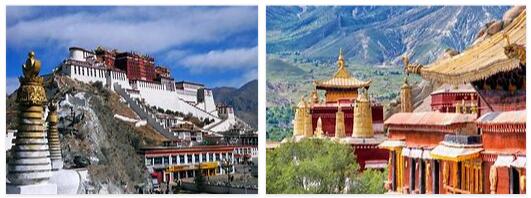
Trashilhünpo
The Trashilhünpo Monastery rises above steep streets in western Tibet. It is the seat of the Penchen Lama, the second highest reincarnation of the Gelugpa lineage of Tibetan Buddhism. Gold-adorned roofs swing over the red stone walls of the huge complex. The monastery is located west of the city of Xigazé, capital of the western administrative district of Tibet.
Golden treasures for Buddha and the Lama
Trashilhünpo was founded by the first Dalai Lama in the middle of the 15th century and is now one of the most important monastery universities for Buddhist scriptures.
Several Penchen Lamas were buried here. The stupas dedicated to them watch over the graves, adorned with gold and jewels. In the large Matreya hall in the center of the monastery, a 26 meter high Buddha statue rests in a typical posture; it was made of gold and bronze and decorated with precious stones and corals.
Monks in magenta-colored robes lead visitors through the monastery complex and tell about life in the monastery, the tradition and history of the place.
A lavish festival: celebrations in honor of the Buddha
Every year in July, the three-day Buddha presentation takes place here. Sutras are read, the monks bless the visitors and pray for rain and a good harvest. An image of the Buddha is ceremonially unveiled under the sound of Tibetan horns. This festival in honor of the Penchen Lama has been a tradition for five hundred years.
A visit to the Trashilhünpo Monastery gives an impressive insight into the world of modern Tibetan monks and their tradition.
Samye monastery
The beautiful Samye Monastery is only 38 kilometers away from the city of Tsedang, about 60 km east of Lhasa. It is the oldest Buddhist monastery in Tibet. The monastery was built as Manadala and is located on the north bank of the Yarlung River. The complex consists of a three-story central temple, in which the individual floors were built in the country-specific style of India, China and Tibet. The main building of the monastery is the huge Wuze Hall. It represents the center of the world. Each floor stands for a country of the above. The monastery is steeped in history and is often the destination of pilgrimages. It is beautifully situated on a hill with a fantastic view over the country.
When the monastery was founded, the most important elements of Tibetan Buddhism and belief were combined here. On the one hand there is the respect for the Dharma, the worship of the Buddha and the establishment of an order of monks.
History
The Samye Monastery was built around 775. A tantric master and an abbot from an Indian monastery university directed the construction of the facility. A council is said to have taken place here at the end of the 8th century. In the 9th century Buddhist scriptures were translated from Indian into Tibetan in Samye Monastery.
During the reign of Lang Darma, the practice of Buddhism was banned in the country. Many Buddhist temples were destroyed by him. Some wars that raged in the country naturally also left their mark on the complex. It took about 200 years for the monastery to be revived. Around 1930 the monastery complex was again orphaned and was desecrated and looted during the Cultural Revolution. At the end of the 1980s, the Samye Monastery was rededicated.
Today monks live and pray here again. Tour groups also come here and look at the symbol of Buddhism. Wall paintings and stone statues inside the monastery are particularly attractive.
Rongbuk monastery
the tallest monastery in the world in Tibet
The Rongbuk Monastery is about 4980 meters above sea level, making it the highest monastery in the world. It is located on the north side of Mount Everest and is ideal for a stopover before the journey continues to Everest Base Camp, 8 km away. A special feature of the sectarian monastery built by the Nyingmapa in 1899 is that both monks and nuns live here. The Rongbuk Monastery impresses with its simple beauty and the tranquility it exudes in the midst of breathtaking nature.
Worth seeing in the Rongbuk monastery
Large parts were destroyed during the Chinese Cultural Revolution. Fortunately, some rooms have been preserved and renovations were carried out in 1983. On the first floor there is a hall with beautiful wall paintings. In the outer hall on the second floor the nuns and monks sing and pray and inside there is a large statue of Padmasambhava. Next to the monastery there is a simple guest house and a small but cozy restaurant.
Mount Everest viewing platform
The location of the Rongbuk Monastery at the northern foot of Mount Everest offers a phenomenal view of the highest mountain in the world. A viewing platform near the monastery is ideal for breathtaking photos. Mount Everest is particularly impressive at sunrise and sunset, when the summit shines in golden light. The best months for study trips are April, May, September and October.
Tibetan Festival dance ceremony
Every year on April 15 of the Tibetan calendar, a grand dance ceremony, the Saka Dawa Festival, is held in the courtyard of the Rongbuk Monastery to celebrate the birth of Sakyamuni. Adorned with prayer flags and colorful ornaments, the monastery is open to visitors who want to see the performance. The monks dress up and perform Tibetan dances. The festival lasts three days, during which the otherwise quiet Rongbuk Monastery is exuberant and lively.